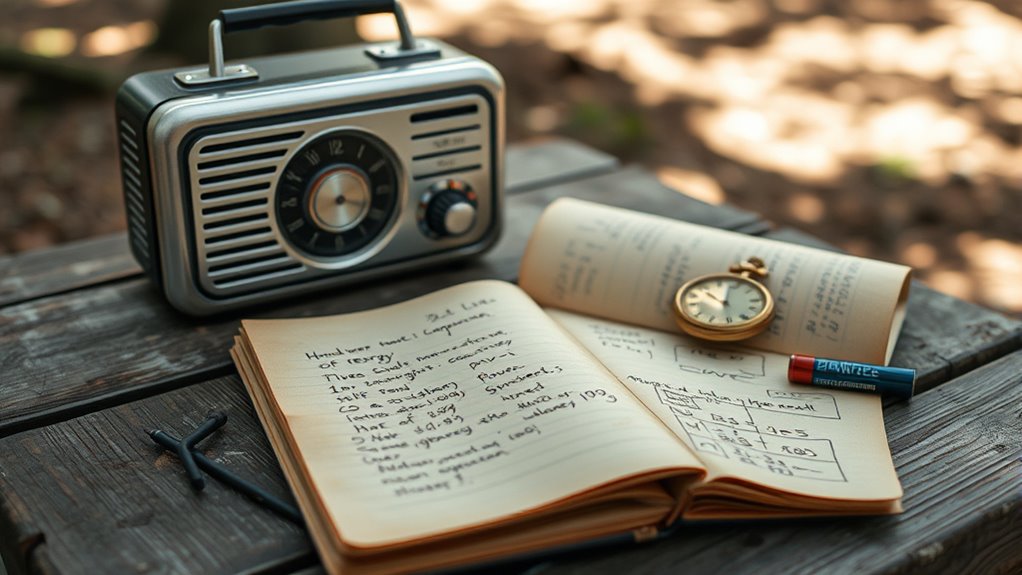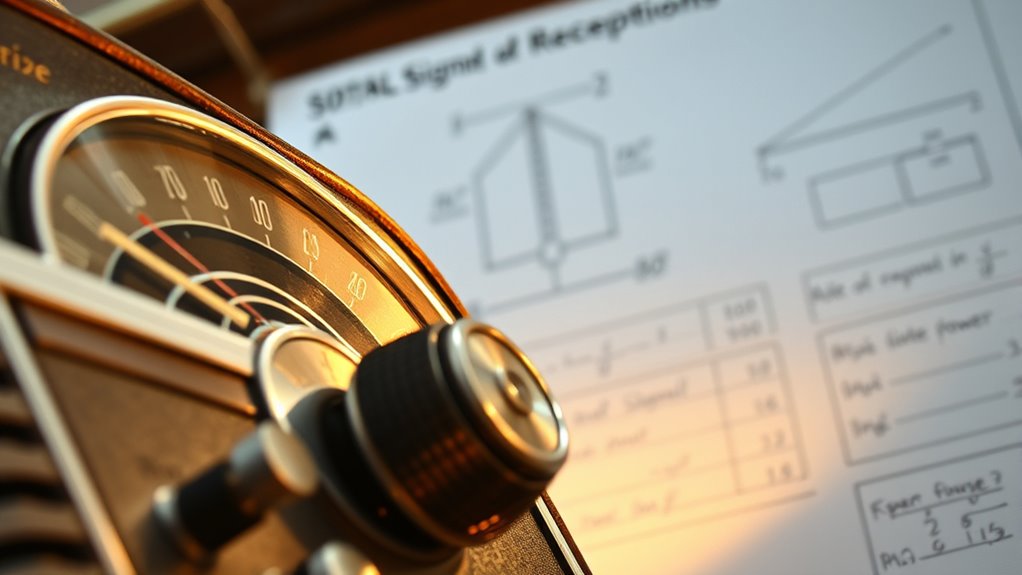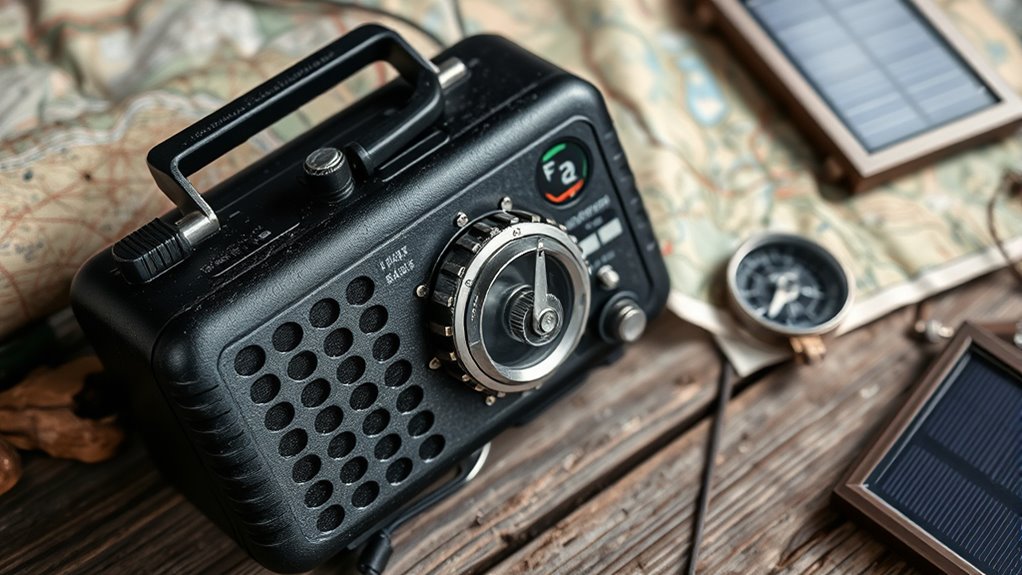To plan your hand crank radio effectively, you need to calculate battery capacity, expected run time, and efficiency. Understand the types of batteries you’ll use, how long they last, and how much power your radio demands. Add solar and hand crank input estimates for reliable energy. Optimize signal reception by adjusting antennas carefully. To guarantee durability, select weather-resistant materials. Keep these calculations in mind, and you’ll be better equipped to build a dependable emergency radio—more details are just ahead.
Key Takeaways
- Calculate hand crank energy output in milliwatt-hours to determine recharge time for batteries based on efficiency.
- Assess the radio’s power consumption (in watts) to estimate how long a charged battery or cranked energy will last.
- Combine solar panel input with hand crank output to optimize recharge cycles and ensure reliable power supply.
- Consider gear ratios and friction losses in the crank mechanism to accurately measure actual energy transferred.
- Evaluate environmental factors like sunlight exposure and weather conditions to plan effective power generation and storage.
Understanding Power Storage Capacity

Have you ever wondered how long your hand crank radio can keep running during an emergency? Understanding power storage capacity is key. Different battery types, like alkaline, NiMH, or lithium-ion, each have unique advantages and limitations. Alkaline batteries are easy to find but tend to drain faster, while rechargeable batteries like NiMH can be reused, saving money over time. Proper storage techniques also impact battery life; keep batteries in a cool, dry place away from direct sunlight to prevent deterioration. Using sealed, moisture-proof containers helps protect batteries from environmental damage. Battery lifespan depends on proper usage and storage practices, which are crucial for maintaining optimal performance. Knowing the types of batteries your radio uses and adopting effective storage techniques guarantees you’re always ready when power is needed most. This knowledge helps optimize your radio’s run time during critical moments.
Calculating Battery Life and Run Time

Knowing how long your hand crank radio can operate depends on accurately calculating its battery life and run time. To do this, consider the radio’s power consumption, which varies with features like solar charging and frequency modulation. Solar charging can extend run time by replenishing batteries during daylight, so factor in sunlight exposure and solar panel efficiency. Frequency modulation (FM) broadcasts typically use less power than other modes, helping conserve battery life. Calculate your radio’s average power draw and divide the battery capacity by this number to estimate run time. Additionally, understanding power efficiency can help optimize your radio’s usage and battery longevity. Keep in mind that real-world conditions, such as signal strength and user activity, can affect actual performance. Regularly monitoring these factors helps ensure your radio stays operational when you need it most.
Estimating Charging and Hand Crank Efficiency

Estimating how effectively your hand crank radio can be charged involves understanding both the efficiency of the hand crank mechanism and the energy it generates. Hand cranks convert manual effort into electrical energy, but their efficiency varies based on design. To improve emergency preparedness, consider supplementing with solar panels, which can provide a steady power source when cranking isn’t possible. Measuring the energy output from your hand crank, typically in milliwatt-hours, helps determine how long it takes to recharge your radio’s batteries. Keep in mind that factors like friction and gear ratios affect efficiency. Additionally, understanding energy conversion processes helps optimize the overall power management strategy. Combining hand crank and solar charging options ensures reliable power during emergencies, reducing dependency on external power sources and maximizing your radio’s readiness when it matters most.
Determining Signal Reception and Output Power

To determine your hand crank radio’s signal reception and output power, start by tuning into different radio frequencies and noting the clarity and strength of each signal. Proper antenna positioning plays a vital role; experiment with angles and distances to maximize reception. Guarantee your radio’s antenna is fully extended and positioned away from obstructions. Additionally, check for frequency compatibility—some radios perform better on specific bands like AM or FM, so test these thoroughly. Pay attention to how well the radio picks up signals at various locations, adjusting the antenna accordingly. This process helps you identify the best setup for reliable reception and ideal output power, ensuring your radio performs well during emergencies or outdoor activities. Being aware of antenna positioning can significantly improve signal quality and overall performance.
Assessing Durability and Environmental Factors

Evaluating your hand crank radio’s durability and how it withstands environmental conditions makes certain of reliable performance when you need it most. Focus on the battery materials, as they impact longevity and performance in tough conditions. Look for batteries with robust, corrosion-resistant components that withstand temperature fluctuations and moisture. Weather resistance is equally important; choose a radio with sealed enclosures or weatherproof coatings to prevent water ingress and dust intrusion. Consider materials like rugged plastics or rubberized casings that absorb shocks and resist impacts. Testing or reviewing the device’s specifications for environmental ratings, such as IP (Ingress Protection) ratings, can give you confidence in its durability. Battery quality plays a crucial role in ensuring consistent performance during extended use or in harsh environments. A well-built radio ensures you stay connected during emergencies, regardless of external conditions.
Frequently Asked Questions
How Do Weather Conditions Affect Hand Crank Radio Performance?
Weather conditions can considerably impact your hand crank radio’s performance. Rain, snow, or fog may weaken signals, especially if your antenna isn’t properly oriented. Heavy storm activity can cause signal interference, making it harder to receive broadcasts. To improve reception, adjust your antenna orientation and find a higher, less obstructed spot. Being aware of these factors helps you stay connected during adverse weather, ensuring reliable information when you need it most.
What Safety Precautions Should I Take During Manual Operation?
Sure, because risking a finger cramp during emergency preparedness is just what you need. Always keep your fingers clear of moving parts, handle the crank gently, and avoid overexertion. Use safe handling techniques, wear protective gear if necessary, and don’t rush. Remember, a well-prepared person prioritizes safety over speed. Stay vigilant, follow manufacturer instructions, and stay safe while manually operating your radio during emergencies.
Can I Use Rechargeable Batteries With Hand Crank Radios?
Yes, you can use rechargeable batteries with your hand crank radio, but you should check the battery compatibility first. Some models are designed specifically for standard batteries, while others support rechargeable options. Keep in mind that rechargeable batteries may offer different charging options, such as USB or solar charging, making them more convenient. Always verify your radio’s specifications to guarantee safe use and peak performance with rechargeable batteries.
How Often Should I Calibrate or Test the Device?
You should calibrate or test your hand crank radio at least once every six months to guarantee accurate readings and peak performance. Regular battery maintenance, including checking rechargeable batteries and replacing them when needed, helps maintain device reliability. Calibration frequency depends on how often you use the radio and environmental factors, but consistent testing keeps your device ready for emergencies. Stay proactive to keep your radio functioning properly.
Are There Legal Restrictions on Signal Reception in Certain Areas?
Think of the airwaves as a guarded treasure chest—certain signals are off-limits without proper keys. You must adhere to regulatory compliance and licensing requirements, as some areas have strict restrictions on signal reception. Violating these rules can lead to fines or legal trouble, so always research local laws before tuning in. Respecting these boundaries guarantees you enjoy your hand crank radio without crossing any invisible lines.
Conclusion
By mastering these calculations, you’ll confidently choose a hand crank radio that keeps you connected during emergencies. Imagine a hiker relying on a well-calculated radio, ensuring they stay informed even in remote areas. With careful planning—considering battery life, crank efficiency, and durability—you’ll maximize your device’s performance when it matters most. So, take the time to do the math; it could make all the difference when you need reliable communication the most.









